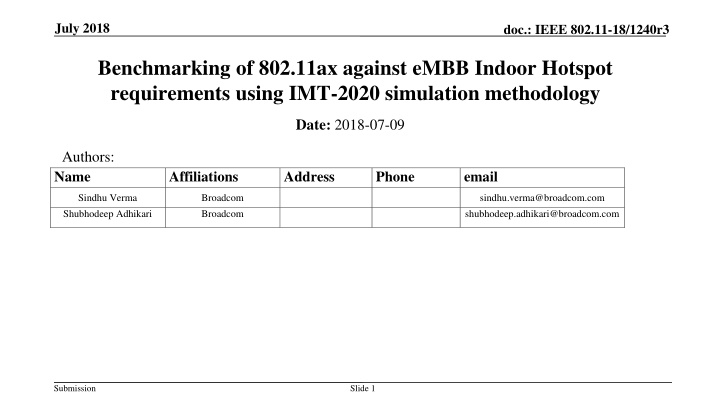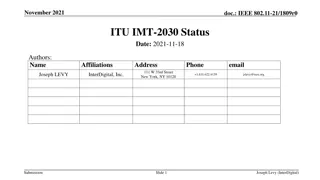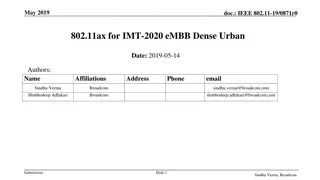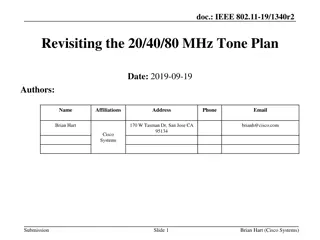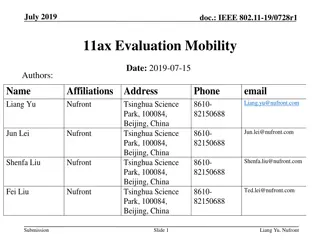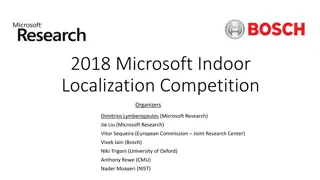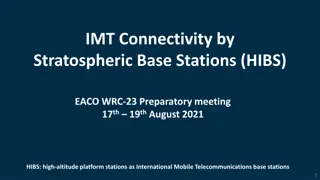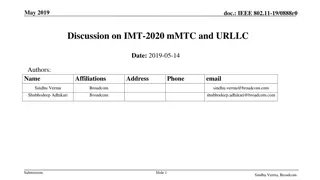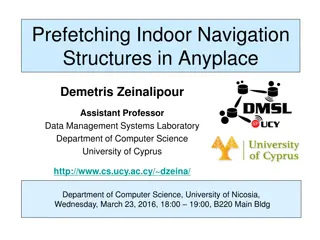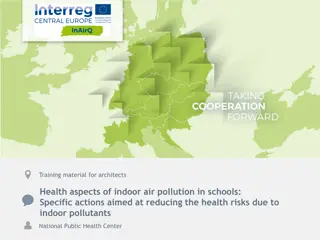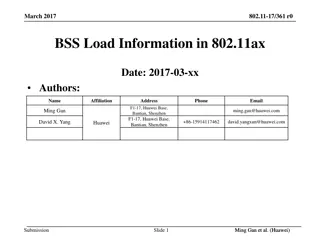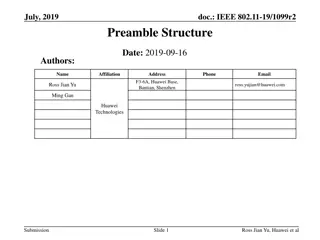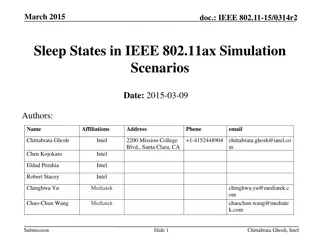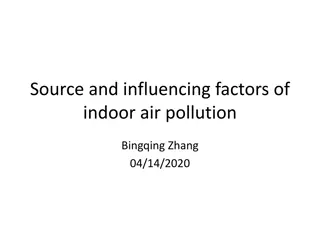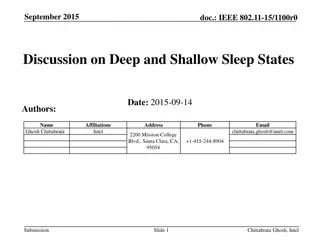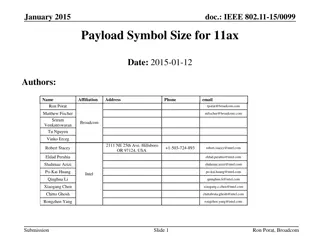Benchmarking of 802.11ax for eMBB Indoor Hotspot Using IMT-2020 Simulation Methodology
This presentation continues the benchmarking of 802.11ax capabilities concerning IMT-2020 requirements for eMBB Indoor Hotspot and Dense Urban test environments. The simulations cover UL, mobility aspects, and adherence to ITU-R methodology. Analytical evaluations and simulation results demonstrate that 802.11ax meets requirements for various metrics required for IMT-2020 evaluation.
Download Presentation

Please find below an Image/Link to download the presentation.
The content on the website is provided AS IS for your information and personal use only. It may not be sold, licensed, or shared on other websites without obtaining consent from the author.If you encounter any issues during the download, it is possible that the publisher has removed the file from their server.
You are allowed to download the files provided on this website for personal or commercial use, subject to the condition that they are used lawfully. All files are the property of their respective owners.
The content on the website is provided AS IS for your information and personal use only. It may not be sold, licensed, or shared on other websites without obtaining consent from the author.
E N D
Presentation Transcript
July 2018 doc.: IEEE 802.11-18/1240r3 Benchmarking of 802.11ax against eMBB Indoor Hotspot requirements using IMT-2020 simulation methodology Date: 2018-07-09 Authors: Name Affiliations Address Phone email Sindhu Verma Shubhodeep Adhikari Broadcom Broadcom sindhu.verma@broadcom.com shubhodeep.adhikari@broadcom.com Submission Slide 1
July 2018 doc.: IEEE 802.11-18/1240r3 Abstract This presentation is a continuation of the benchmarking of 802.11ax capabilities vis- -vis the IMT-2020 requirements for eMBB Indoor Hotspot and Dense Urban test environments ([1] and [2]). In [3], we had used an analytical approach using the IMT and 3GPP configurations to conclude that 802.11ax can meet the above requirements. In [4], we presented simulations that showed that 802.11ax meets the IMT-2020 requirements for DL eMBB Indoor Hotspot. In this contribution, we present simulations regarding 802.11ax capabilities for UL and mobility aspects of eMBB Indoor Hotspot. The simulations adhere to the methodology specified by ITU-R for self-evaluating a RAT for IMT-2020 ([1] and [2]). This is the same procedure that is being used in 3GPP for self-evaluation of NR and LTE for IMT-2020. Submission Slide 2
July 2018 doc.: IEEE 802.11-18/1240r3 Outline Background Simulation setup Simulation configuration and assumptions Simulation methodology Results Conclusions Next Steps References 1. 2. 3. 4. 5. 6. 7. 8. Submission Slide 3
July 2018 doc.: IEEE 802.11-18/1240r3 Background (1) 1. According to the IMT-2020 self-evaluation criteria, a candidate RAT needs to meet the minimum requirements for the following metrics for any given use case in eMBB: 1. Peak Spectral Efficiency 2. Peak Data Rate 3. 5%ile User Spectral Efficiency 4. 5%ile User Experienced Data Rate 5. Average Spectral Efficiency 6. Area Traffic Capacity 7. Mobility 2. The above metrics must be evaluated as follows: 1. Peak Spectral Efficiency and Peak Data Rate must be evaluated analytically. 2. 5%ile User Spectral Efficiency, Average Spectral Efficiency and Mobility must be evaluated based on the simulation methodology specified by ITU-R. 3. 5%ile User Experienced Data Rate is derived from 5%ile User Spectral Efficiency, while the Area Traffic Capacity is derived from the Average Spectral Efficiency. Submission Slide 4
July 2018 doc.: IEEE 802.11-18/1240r3 Background (2) In our previous contributions ([3] and [4]) we had presented the following for DL and UL: 1. Analytic evaluations to show that 802.11ax meets the requirements for Peak Spectral Efficiency and Peak Data rate for the Indoor Hotspot and Dense Urban use cases. 2. Simulation results to show that 802.11ax meets the requirements for DL 5%ile User Spectral Efficiency and Average Spectral Efficiency in the Indoor Hotspot use case. In the current contribution we present the following for the Indoor Hotspot use case: 1. Recapitulate the simulation results for the DL 5%ile User Spectral Efficiency and Average Spectral Efficiency 2. Simulation results for the UL 5%ile User Spectral Efficiency and Average Spectral Efficiency. 3. Estimates of DL and UL 5%ile User Experienced Data Rate and Area Traffic Capacity, based on the above simulations. 4. Simulation results for Mobility performance Note: 1. 802.11ax satisfies the bandwidth requirement of 100MHz [1]. 2. 802.11ax also expected to easily satisfy the following requirements [1]: 1. User Plane Latency of 4ms in an unloaded network 2. Control Plane Latency of 20ms This would complete the evaluation of 802.11ax as a PHY/MAC technology for all the significant parameters in the Indoor Hotspot usage scenario per the ITU-R criteria of self-evaluating a RAT for IMT-2020. Submission Slide 5
July 2018 doc.: IEEE 802.11-18/1240r3 Simulation setup 1. The simulations follow the self-evaluation methodology specified by ITU-R ([1] and [2]). 2. The simulator has been calibrated against the IMT-2020 simulation data presented by multiple companies in 3GPP ([5]), with respect to salient channel model parameters such as the geometry SINR, coupling loss, singular values, delay spread, spread of azimuth/elevation departure/arrival angles. This benchmarking step ensures the accuracy of the simulation output in this presentation. 3. The eMBB network topology consists of 12 BSs and 120 UEs as shown below. 4. A constant speed of 3 kmph is assigned to each UE for the DL/UL evaluations and 10 kmph for mobility evaluations. We model actual physical movement of the UEs, whereas only notional mobility (i.e. only fades at the given speed) could have sufficed. In our model, the UEs are contained within the network layout by being reflected from the network edge once they reach it. Submission Slide 6
July 2018 doc.: IEEE 802.11-18/1240r3 Simulation configuration and assumptions Configuration: 1. Simulation bandwidth : 20 MHz 2. BS Tx power : 24 dBm, UE Tx power: 23 dBm 3. BS Antenna gain: 5 dBi, UE antenna gain: 0 dBi 4. BS noise figure: 5 dB, UE noise figure : 7 dB 5. BS antenna configuration : 8Tx/8Rx omni uniform linear array with 5 dBi gain in intended direction. 6. UE antenna configuration : 8Tx/8Rx omni uniform linear array with 0 dBi gain. 7. The complete configuration is specified in the ITU-R guidelines for self-evaluating a RAT ([1] and [2]). Additional assumptions: 1. Realistic/Imperfect CSI at the transmitter 2. SVD based beamforming 3. Max MU-MIMO factor of 2 4. Full interference in DL and UL Submission Slide 7
July 2018 doc.: IEEE 802.11-18/1240r3 Simulation configuration and assumptions 1. Antenna configuration: a) The IMT-2020 Indoor Hotspot configuration allows up to 256 Tx/Rx at the BS and up to 8 Tx/Rx at the UE. b) However, in the simulations we used only 8 Tx/Rx at the BS and UE to conform to the current capabilities of 802.11ax. c) We have done this even though IMT-2020 evaluations permit the inclusion of features and/or extensions that may be available in the future. d) Note also that an antenna configuration with greater than 8 Tx-Rx can be implemented at both BS and UE without standards support. For example, the 3GPP antenna patterns allow for vertical/horizontal/polarization elements where vertical elements may not increase the dimension of the channel matrix. Hence, such schemes do not require standards support for larger CSI feedback, but can provide higher diversity and gain. e) We have also assumed omni antennas whereas directional antennas can be used. Directional antennas provide higher gain (with appropriate beam-training) and also attenuate interference. 2. MU-MIMO factor: A BS-UE antenna configuration of (BS Tx/Rx, UE Tx/Rx) = (256/256, 8/8) or even (8/8, 8/8) allows for a large MU-MIMO factor that can significantly increase the spectral efficiency. However, in the current simulations we have restricted the MU-MIMO factor to 2. 3. Interference: We have not implemented schemes that can reduce interference such as Interference Coordination and Cancellation, Partial Frequency Reuse etc. The above factors will lead to simulation results that are more conservative than what is expected in practice. Submission Slide 8
July 2018 doc.: IEEE 802.11-18/1240r3 Simulation methodology 1. 12 BSs are assigned fixed locations in the 120m by 50m layout as shown in Slide 6. 2. 120 UEs are placed randomly in the layout and assigned random directions. 3. The speed of each UE is 3 kmph for 5%ile user spectral efficiency and average spectral efficiency evaluations and 10 kmph for mobility evaluations 4. The 8x8 channel between each UE and BS is estimated at each time snapshot. 5. There are 50 time snapshots (or samples) per 1m of movement. This amounts to 1 sample every ~ 24 ms for 3kmph and 1 sample every ~7.2 ms for 10kmph. 6. The RSSI at each UE from a BS is calculated as the sum of power from all sub-paths and antenna links. 7. Each UE is associated with the BS that has the strongest DL RSSI. 8. Beamforming based on Singular Value Decomposition (SVD) is used where the SVD is calculated for each RU (9 RUs make 20 MHz). 9. The CDF of SU-MIMO and MU-MIMO spectral efficiencies over users, frequency and time is plotted. Submission Slide 9
July 2018 doc.: IEEE 802.11-18/1240r3 Results (1) 1. The graphs show the DL/UL spectral efficiency and mobility evaluation of 802.11ax with SU-MIMO and 2-factor MU-MIMO. 2. The CDFs have been generated by calculating the spectral efficiency for each time snapshot in the simulator. 1. SU-MIMO: Spectral efficiency for each user for each RU, assuming only SU-MIMO. The spectral efficiency is calculated as the maximum of the spectral efficiencies for 1 to 8 spatial streams. 2. 2-factor MU-MIMO: Spectral efficiency for each combination of 2 users connected to the same BS for each RU, assuming only 2-factor MU-MIMO. The spectral efficiency is calculated as the maximum of the spectral efficiencies for each number of possible spatial streams for individual users in the combination. 3. Note that the spectral efficiency of 802.11ax simulated in this manner is conservative since: 1. It does not consider multi-user scheduling gain 2. Restricts the choice to either fully SU-MIMO or fully 2-factor MU-MIMO and hence does not consider the gain possible by dynamically allocating a user to either SU-MIMO or MU-MIMO based on whichever scheme gives the best user/system throughput. 3. This is in addition to the conservative antenna configuration, interference coordination and MU-MIMO factor choices described earlier. Submission Slide 10
July 2018 doc.: IEEE 802.11-18/1240r3 Results (2) : 5%ile and Average DL spectral efficiencies The pre-scheduling per-user DL spectral efficiencies are found to be as follows. SU-MIMO: 5%ile = 4 bits/s/Hz Average = 9.5 bits/s/Hz 2-factor MU-MIMO: 5%ile = 5.1 bits/s/Hz Average = 11.1 bits/s/Hz With a simple equal-time scheduler targeting a PER of 10%, the final spectral efficiencies are as: SU-MIMO: 5%ile = 0.35 bits/s/Hz Average = 8.41 bits/s/Hz 2-factor MU-MIMO: 5%ile = 0.45 bits/s/Hz Average = 9.82 bits/s/Hz Conclusion: 802.11ax in its current configuration, satisfies the IMT- 2020 Indoor Hotspot DL 5%ile and Average spectral efficiency requirements of 0.3 bits/s/Hz and 9 bits/s/Hz respectively. Submission Slide 11
July 2018 doc.: IEEE 802.11-18/1240r3 Results (3): 5%ile and Average UL spectral efficiencies The pre-scheduling per-user UL spectral efficiencies are found to be as follows. SU-MIMO: 5%ile = 1.2 bits/s/Hz Average = 12.8 bits/s/Hz 2-factor MU-MIMO: 5%ile = 5.9 bits/s/Hz Average = 15.49 bits/s/Hz With a simple equal-time scheduler targeting a PER of 10%, the final spectral efficiencies are: SU-MIMO: 5%ile = 0.11 bits/s/Hz Average = 11.32 bits/s/Hz 2-factor MU-MIMO: 5%ile = 0.52 bits/s/Hz Average = 13.7 bits/s/Hz Conclusion: 802.11ax in its current configuration, satisfies the IMT- 2020 Indoor Hotspot UL 5%ile and Average spectral efficiency requirements of 0.21 bits/s/Hz and 6.75 bits/s/Hz respectively. Submission Slide 12
July 2018 doc.: IEEE 802.11-18/1240r3 Results (4) : User Experience Data Rate and Area Traffic Capacity Based on the simulated 5%ile spectral efficiency: DL user experienced data rate = 0.45 bits/s/Hz * 320 MHz = 144 Mbps UL user experienced data rate = 0.52 bits/s/Hz * 320 MHz = 166.4 Mbps 802.11ax in its current configuration, satisfies the IMT-2020 Indoor Hotspot DL and UL User Experience Data requirements of 100 Mbps and 50 Mbps respectively Based on simulations, the average DL spectral efficiency = 9.82 bits/s/Hz From the eMBB Indoor Hotspot topology: area of each site = 500 m2. For 1 TRxP/site, = 1/500 = 0.002 TRxP/m2 For 3 TRxP/site, = 0.006 TRxP/m2 So, the DL Area traffic capacity = 0.01964*W Mbps/m2for 1 TRxP/site and 0.05892*W Mbps/m2for 3 TRxP/site The Area Traffic Capacity requirement of 10 Mbps/m2can be met by 802.11ax with an aggregate DL bandwidth of 510 MHz and 170 MHz for 1 TRxP/site and 3 TRxP/site respectively. The latter bandwidth is easily supported by 802.11ax. Submission Slide 13
July 2018 doc.: IEEE 802.11-18/1240r3 Results (5) : Mobility Mobility requirement is met if the technology satisfies a UL spectral efficiency of 1.5 bits/s/Hz at the 50% SINR CDF for Indoor Hotpot at 10 kmph: The pre-scheduling per-user UL spectral efficiencies for UE speeds of 10 kmph are as follows. SU-MIMO: 50%ile = 8 bits/s/Hz 2-factor MU-MIMO: 50%ile = 11.8 bits/s/Hz With 10 users per BS, a simple equal-time scheduler targeting a PER of 10% and considering mid-ambles to aid channel estimation at 10kmph, the final spectral efficiencies are as: SU-MIMO: 50%ile =6.37 bits/s/Hz 2-factor MU-MIMO: 50%ile = 9.4 bits/s/Hz Conclusion: The simulations show that 802.11ax in its current configuration, satisfies the IMT-2020 Indoor Hotspot mobility requirement of 1.5 bits/s/Hz. Submission Slide 14
July 2018 doc.: IEEE 802.11-18/1240r3 Conclusions 1. 802.11ax simulations were performed using the configuration and methodology specified by ITU-R for self evaluating a RAT for IMT-2020 compliance. 2. Simulations were performed for the downlink/uplink and mobility of the Indoor Hotspot test environment. The simulations show that even with conservative assumptions, 802.11ax downlink in its currently standardized configuration, is able to comfortably satisfy the 5%ile Spectral Efficiency and Average Spectral Efficiency requirements for Indoor Hotspot. 3. The 5%ile User Experienced Data Rate is derived analytically from 5%ile Spectral Efficiency, while the Area Traffic Capacity is derived analytically from the Average Spectral Efficiency. 4. So, 2) and 3) together mean that 802.11ax satisfies the 5%ile Spectral Efficiency, 5%ile User Experienced Data Rate, Average Spectral Efficiency, Area Traffic Capacity and Mobility for Indoor Hotspot. 5. The remaining metrics of Peak Spectral Efficiency and Peak Data Rate have to be evaluated analytically per the ITU-R methodology and it has already been shown in the presentation [3] that 802.11ax satisfies these metrics. 6. 802.11ax also satisfies the Bandwidth requirement while it is also expected to easily satisfy the requirements for User Plane and Control Plane latency. Conclusion: 802.11ax as a PHY/MAC technology even in its currently standardized form satisfies the relevant IMT-2020 requirements for Indoor Hotspot. Submission Slide 15
References July 2018 doc.: IEEE 802.11-18/1240r3 [1] Report ITU-R M.2410-0 (11/2017), Minimum requirements related to technical performance for IMT-2020 radio interface(s) [2] Report ITU-R M.2412-0 (10/2017), Guidelines for evaluation of radio interface technologies for IMT-2020 [3] IEEE 802.11-18/0517r1, 802.11ax for IMT-2020 EMBB Indoor Hotspot and Dense Urban, March, 2018 [4] IEEE 802.11-18/915r2, 802.11ax for IMT-2020, May, 2018 [5] RT-170019, Summary of email discussion [ITU-R AH 01] Calibration for self-evaluation , Huawei, December 2017 Submission Slide 16
